The Shanghai Stock Market Bubble and the "Euro/Yen" Tug-of-War
Stock-Markets / Yen Carry Trade Mar 27, 2007 - 11:10 AM GMTBy: Gary_Dorsch
"Free markets for Free men", was a slogan etched on the floor jackets of several traders at the Chicago Mercantile Exchange in the 1980's. But today, the slogan for traders is "Rigged markets for Central bankers," who try to move currency and stock markets with their control of the money spigots and timely "jawboning" to the media outlets, when markets become unruly. Today, trading in currencies, precious metals, and stock market indexes has turned into a game of central bank watching.
Right now, two of the most important pieces of the global market jig-saw puzzle are the Shanghai Stock Index bubble and the Tug-of-war over the "Euro /yen" carry trade. What happens in Shanghai can have a big influence over China's monetary policy, and is of great interest to commodity traders and Asian stock markets. The upcoming battle over the Euro /yen exchange rate can have a big influence over Japanese monetary policy and stock markets in Europe.
How will Beijing Deal with the Shanghai Bubble?
The 9% plunge in the Shanghai stock market on Feb 27th, was widely blamed for igniting the $1.5 trillion global stock market shake-out. Within hours of the Shanghai plunge, the Dow Jones Industrials fell as much as 550-points, forcing the US Treasury to issue a plea for calm. Yet the market which ignited the global panic in the first place, was the first to recover and then rumbled to new all-time highs.
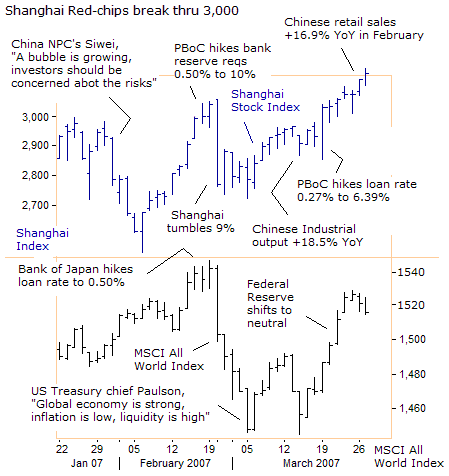
The Shanghai Composite Index climbed to a new all-time high of 3,144-points four weeks later, overcoming heavy profit-taking, and is now beginning a new leg up. Technical analysis suggests an initial upside target of 3,250 with support at the January and February peaks around 3,000. The Shanghai index has already tripled since May 2005 and is up 17.5% so far this year, with many stocks trading at multiples above 40 times earnings, the most expensive in Asia.
Yet without a tighter Chinese monetary policy, the Shanghai A-share market could inflate into a Nasdaq-like bubble, and if it should burst from much higher levels, it could deal a big blow to China's economy, and have a chilling effect on Hong Kong-listed stocks. But it remains an open question of how far Beijing is actually willing to tighten its money spigots to keep this raging bull market under wraps.
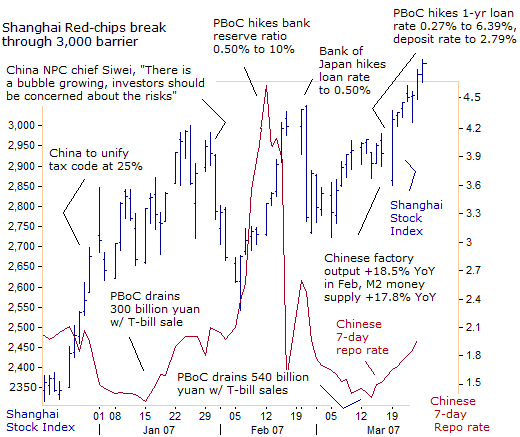
It's a long war, and a determined central bank with enormous financial resources can eventually gain the upper hand over market speculators, if it is willing to pay the price. So far this year, Beijing has launched three salvos aimed at local stock market operators, in an effort to cap the Shanghai Composite Index of "A" and "B" shares below the psychological 3,000 level, but hasn't yet pricked the market bubble.
The opening salvo aimed at Shanghai traders was launched on Jan 31st, by Cheng Siwei, vice-chairman of the National People's Congress. "There is a bubble growing. Investors should be concerned about the risks. But in a bull market, people will invest relatively irrationally. Every investor thinks they can win. But many will end up losing. But that is their risk and their choice," Cheng warned.
"Jawboning" is usually the first weapon of choice for government interventionists, because it's cost free. Cheng's scare tactic worked for a week, knocking Shanghai red-chips into a 15% swoon by February 7th. However, two weeks later, the buoyant Shanghai stock index was climbing above 3,000 for a second time. The PBoC turned jawboning into action, by lifting bank reserve ratios 0.5% to 10% on Feb 19th.
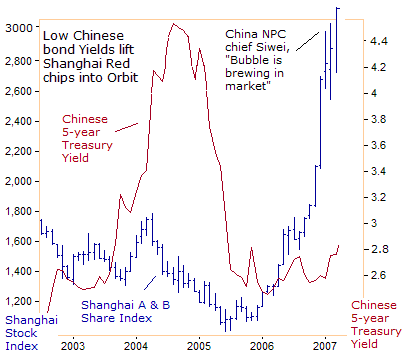
The PBoC surprised the Shanghai money markets, and the 7-day repo rate briefly spiked upward by 1% to 2.65%, greasing the skids for the 9% plunge in Shanghai red-chips on Feb 27th. But the surge in the 7-day repo rate was a false alarm, and when the liquidity gauge drifted down to as low as 1.42% on March 13th, the Shanghai stock Index mounted its third attempt to breach the 3,000-mark
The third attempt to douse the Shanghai red-chips rally was unleashed on March 16th, when the PBoC hiked its deposit and lending rates by 0.27 percent. But China's money markets are still flush with cash. China's 5-year Treasury bond yield of 2.85% is barely above the 2.7% consumer inflation rate, offering a zero percent real rate of return. The 5-year Chinese bond yield is far below the peak of 4.55% set in 2004, the last time Beijing admitted to a flare-up of inflation.
The PBoC sells T-bills to soak up yuan and then re-invests the money into higher yielding foreign currency bonds, - otherwise known as a "carry trader". China held $353.6 billion in US Treasury securities in January, second only to Japan in value of Treasuries held, but holds most of its $1.07 trillion in FX reserves in US institutional bonds, corporate bonds, and mortgage-backed securities, the PBoC said on March 18th. Its holdings also include a range of currencies besides the US dollar, such as the Euro, the Japanese yen and the British pound.
The PBoC's T-bill sales are calibrated to siphon off roughly $25 billion of monthly currency inflows from foreign trade and investment, but are not indicative of a tighter money policy. Recently however, the PBoC was more aggressive in draining liquidity, selling a net 540 billion yuan ($70 billion) of T-bills, and guiding the 7-day repo rate from a low of 1.42% to as high as 1.95% on March 27th.
Shanghai Bubble Inflated by "cheap yuan" Policy
China's economy expanded 10.7% in 2006, led by a 27% surge in exports to a record $969 billion, and notching up double-digit growth for the fourth year in a row. One of the ingredients to China's stunning success is its manipulation of the yuan, which is undervalued on a trade weighted basis by 35 percent. China earned a $177 billion trade surplus last year and attracted $63 billion in foreign direct investment.
The Chinese central bank prints massive amounts of yuan to buy the foreign currency that is flooding into the country. For the past four years, China's M2 money supply has increased between an annualized 13.5% to as high as 21.5%, with an average rate of 17.5 percent. In other words, China's M2 money supply is 70% higher from four years ago, and its economy has grown by over 40 percent.
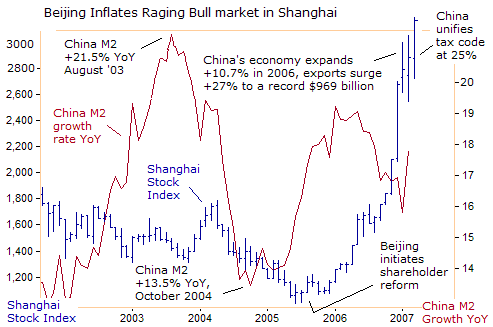
But the PBoC hasn't raised interest rates high enough to slow loan demand, which is essential to bring its M2 money supply under control. Lending surged by 413.8 billion yuan in February, compared with an increase of 149.1 billion yuan in February 2006. M2 money growth jumped to an annualized 17.8% in February from 15.9% in January. So Shanghai red-chip speculators are inclined to bid share prices higher, with so much easy money floating around in a red-hot economy.
Beijing's Mixed Blessing with a cheap US Dollar
China's leaders have opted into a gentleman's agreement with the Bush administration, buying large amounts of depreciating US bonds, in return for assurances of a Bush veto against protectionist legislation from angry Democrats in Congress. China reaped a record trade surplus of $232.5 billion with the United States last year. In the first two months of 2007, China posted a trade surplus of $39.7 billion, triple the total from a year ago.
Yet for China, its massive investment in US T-Notes, when measured against gold or yuan, has sunk to a six year low. And matters are only going to get worse, with Beijing forced to shoot itself in the foot, by devaluing its US dollar assets by about 5% this year against the Chinese yuan. But by Beijing's calculations, the benefits outweigh the costs, after figuring for net interest income and its massive trade surplus with the United States.
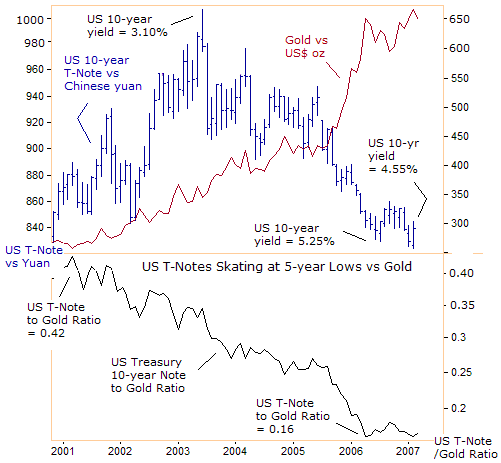
But it will become much harder for Beijing to support the US dollar, once the Federal Reserve begins to lower the federal funds rate and injects more US dollars into the banking system. Former Fed chief "Easy" Al Greenspan said on March 15th, there was a risk that rising defaults in sub-prime mortgage markets could spill over into other economic sectors, raising the odds of a recession.
Greenspan, who helped create and nurture the sub-prime loan debacle in the first place, said much of the strength in US consumer spending over the past five years could be traced to capital gains, both realized and unrealized, on surging housing prices. If US home prices turn south, due to rising loan defaults and foreclosures, it could sink the broader US economy towards zero percent growth.
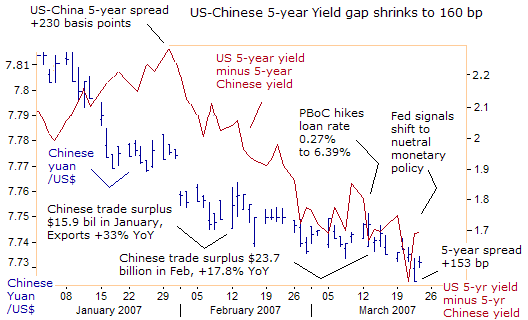
It's quite a balancing act for Beijing, printing yuan on the one hand to cushion the dollar's downfall, while raising bank reserve ratios and interest rates on the other hand, to slow down bank lending. And the high-wire act is a bit more treacherous for the PBoC, after the US dollar's 5-year bond yield fell from a high of +230 basis points over 5-year Chinese bond yields on Feb 1st, to as low as +153 bp last week.
So far, the PBoC has printed enough yuan to limit the dollar's depreciation to just 1% since the beginning of the year. But the slow rate of yuan appreciation might not satisfy the US Congress, which is crafting protectionist legislation against Chinese imports this year. And by printing massive amounts of yuan to offset hot money and trade inflows into the Chinese currency, the PBoC risks generating higher inflation and a bigger stock market bubble in Shanghai. What a tangled web we weave!
The Tug of War over the Euro /Yen "Carry Trade"
"The fact that the Bank of Japan did not raised interest rates hardly surprises me," said EU finance chief Jean Claude Juncker on March 20th, after the BoJ left its overnight call rate target at 0.50 percent. "I think that some people in Europe and elsewhere had got their hopes up after the recent interest rate rise. But we stick to the message that we sent at the G-7 meeting in Essen," Juncker said.
"We think that Japanese growth is without doubt picking up. We think that the yen exchange rate must reflect the fundamental facts of the Japanese economy. Our Japanese friends know that. And we are watching them," Juncker warned.
Juncker's opposition to a weaker yen was backed up by European Central Bank chief Jean "Tricky" Trichet who spoke before the EU Parliament on March 21st. "I have signed the G-7 communique, a very important text, signed by the Americans, the Japanese, the Europeans, and we have all said we are going to continue to keep a very close eye on exchange markets and cooperate as necessary," he said.
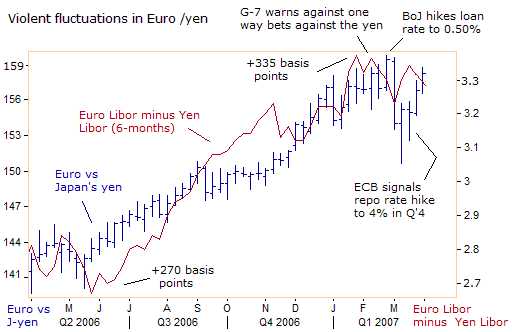
After watching the Japanese yen sink by roughly 65% against the Euro over the past five years, European finance and trade officials are alarmed by Tokyo's "cheap yen" policy, and want the Bank of Japan to raise its interest rates to shore-up the value of the yen. Japan's near-zero interest rates and severely undervalued currency are at the root of the estimated 40-trillion ($440 billion) "yen carry" trade, and massive distortions in global bond and stock markets.
Tokyo's ruling elite did capitulate to heavy European pressure at Essen on Feb 10th, and agreed to a quarter-point BoJ rate hike to 0.50% on Feb 21st, the second increase in five years. But it's hard to get Tokyo to wean itself off low interest rates. "For now, the BOJ will maintain easy monetary conditions, while monitoring economic and price conditions," BoJ chief Fukui told parliament on March 26th.
"The BOJ and the government will work closely. They have to sustain the Japanese economy and get it out of deflation. The price movement is still weak and this is a challenge for the BOJ," said Japan's powerful FX chief Hiroshi Watanabe on March 16th. But European finance ministers know that Japan's low inflation figures are fraudulent, and are not buying Tokyo's deception any longer.
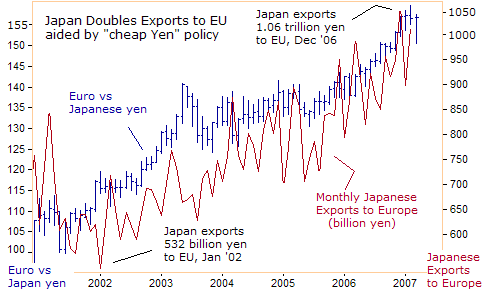
Japanese exports to the European Union have doubled over the past five years to 1.04 trillion yen in February, while European exports to Japan fell 8% during the same time period. But if the Euro's appreciation against the Chinese yuan and Japanese yen is left unchecked, European exporters could suffer in world markets from price handicaps with Japan and cut-throat competition with China.
The clash over the volatile "Euro /yen" carry trade between European and Japanese monetary officials is likely to escalate, with the ECB telegraphing a quarter-point rate hike to 4.00% in the months ahead to counter its exploding M3 money supply, while Japan's FX chief Watanabe is pressuring the BoJ to keep its powder dry. Speculation of a unilateral ECB rate hike, not matched by the BoJ, is behind the Euro's strong rebound from 151-yen on March 5th to as high as 157.5-yen on March 26th.
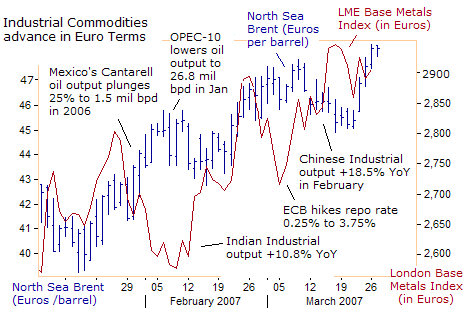
The Euro zone needs a strong Euro /US$ to shield against higher import prices for industrial commodities in the months ahead. "Central banks have to react appropriately to high oil prices pushing up inflation in oil-importing nations, and stop these increases feeding into consumer prices and wages. They must be ready to tighten the monetary reins as soon as significant risks of second-round effects appear," said Spanish central banker Jose Manuel Gonzalez-Paramo on March 16th.
"We see certain clouds on the horizon for the end of the year and for 2008 concerning inflationary developments," said Austrian central banker Klaus Liebscher on March 27th. "So altogether, I think we are not well advised to be too complacent. A very close monitoring of the situation is important, and we will decide what is necessary to keep inflationary expectations under control," Liebscher added. (That's an awful lot of "jawboning", for a baby-step quarter-point rate hike!)
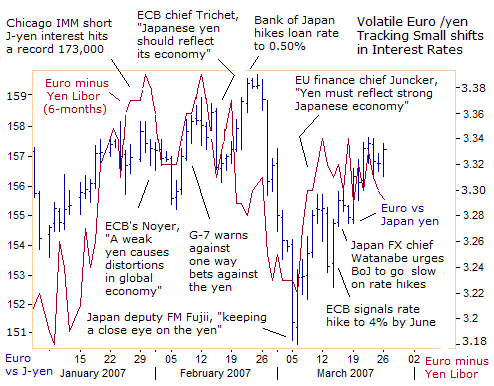
But Japan's economy was sizzling at a 5.5% annualized rate in the fourth quarter, and the "jawboning" signals from Japanese finance officials can change at a moment's notice, to guide the Euro /yen into the secret trading range agreed upon in Essen, Germany on February 10th. BoJ chief Fukui hinted at a third rate hike to 0.75%, in his speech on March 26th, "We will adjust interest rates gradually based on economic and price conditions," he told a parliamentary committee.
"When the economy is recovering or expanding, albeit gradually, there could be side effects if market expectations lean too much towards the view that interest rates will be kept low for too long," Fukui added. Most interesting, is how small shifts in interest rate differentials of just 10 or 15 basis points between the Euro and yen, can lead to such violent swings in the cross rate between the two currencies.
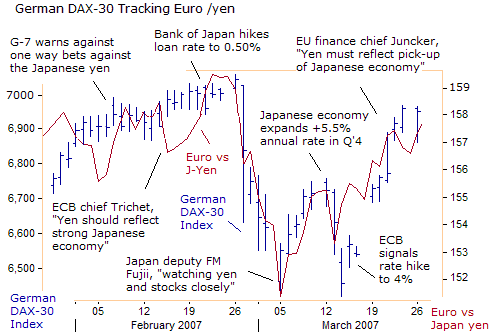
And at least for now, the direction of the Euro/yen exchange rate has become a key driver of the EuroStoxx-600. Europe's top blue chips have been heavily pumped up with Japanese steroids, or cheap-yen margin loans, and have displayed an 88% degree of correlation with the Euro /yen so far this year. Merger and takeover deals worth $311 billion involving European targets have also been announced, just slightly below the record levels in Q'1 of 2006, and buoying equities.
On March 15th, Bundesbank chief Axel Weber warned against the practice of trading European stocks with money borrowed in yen, "The recent correction is a warning that carelessness and under-pricing of risks are not advisable even in a very favorable financial market environment. An unexpected deterioration in the macroeconomic environment could trigger a turnaround in sentiment with widespread repercussions. It is therefore essential that risks are taken into account and priced appropriately," he warned, but few traders are listening.
Bank of Japan is the biggest Player in "Yen Carry" Trade
European finance ministers are finding it difficult to combat the market's addiction to the "yen carry" trade, since the world's biggest addict is the Bank of Japan itself. Tokyo's ministry of finance controls $884 billion of foreign exchange reserves, which are mostly held in US dollars. The MoF borrows yen in Tokyo by selling short-term government paper, and then buys US dollars in the currency market.
The MOF's is paying an interest rate of 0.58% on its intervention financing bills, while earning a 5.05% return in three-month US Treasury bills. As a result, Japan earned about 3-trillion yen in interest income last year, far outstripping its interest expense of 460.6 billion yen. But if the BoJ is forced to raise short-term interest rates to placate Europe, the MoF's interest expense could rise to 1.16 trillion yen in fiscal 2007/08. The spread would get squeezed further, if the Fed lowers US$ rates.
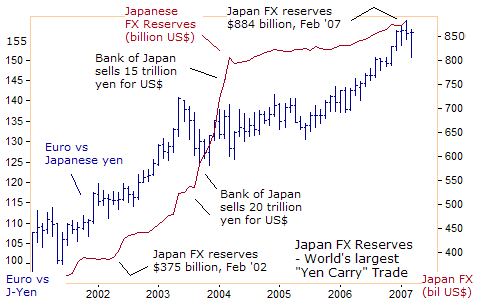
Acknowledging that most of Japan's official reserves are in US dollars, Finance chief Koji Omi told a parliamentary committee on March 23rd, "We have no plan to substantially change the composition." But some Japanese lawmakers say the government's $884 billion intervention fund could be used to help pay down some of Japan's $6.7 trillion national debt, equaling 155% of GDP. Japan is projected to incur $177 billion in interest expense on the debt in the fiscal year ending March 31st.
The possible unwinding of the "yen carry" trade has made European stock markets skittish, but what other powder-keg that could ignite in the future, and trigger another big Euro-Stoxx Index shake-out? Which markets are most impacted by the Shanghai bubble? Which foreign stock market is the first to telegraph the next likely move for the global stock markets? The answers were revealed in the March 23rd edition of Global Money Trends . Next issue is scheduled for March 30th.
By Gary Dorsch, Editor, Global Money Trends newsletter
## “This article is just the Tip of the Iceberg” of what’s available in the Global Money Trends newsletter published around the 1st and 15th of each month in pdf format, and 20-25 pages in length. GMT collects a wide array of news and information from reputable sources, filters out the noise and distractions, and puts all the pieces of the global economic puzzle together into coherent snapshot analyses, with lots of cool charts depicting the inter-relationships of markets and economies from around the world.
Here's what you will receive with a subscription,
Insightful analysis and predictions of, (1) top stock market indexes around the world, and US-listed Exchange Traded Funds (ETF’s) and closed-end country funds. (2) Commodities such as crude oil, copper, gold, silver, the CRB index, and gold mining and oil company indexes. (3) Foreign currencies such as, the Australian dollar, British pound, Euro, Japanese yen, and Canadian dollar. ($) Libor interest rates, global bond markets and their central bank monetary policies.
Subscribers will also receive Email Alerts, sent out in-between regular newsletter postings, when important information unfolds in the global markets. A subscription to Global Money Trends is only $125 US dollars per year for 24 issues, including access to all back issues. Click on the following hyperlink, to order now, http://www.sirchartsalot.com/newsletters.php
Disclaimer: SirChartsAlot.com's analysis and insights are based upon data gathered by it from various sources believed to be reliable, complete and accurate. However, no guarantee is made by SirChartsAlot.com as to the reliability, completeness and accuracy of the data so analyzed. SirChartsAlot.com is in the business of gathering information, analyzing it and disseminating the analysis for informational and educational purposes only. SirChartsAlot.com attempts to analyze trends, not make recommendations. All statements and expressions are the opinion of SirChartsAlot.com and are not meant to be investment advice or solicitation or recommendation to establish market positions. Our opinions are subject to change without notice. SirChartsAlot.com strongly advises readers to conduct thorough research relevant to decisions and verify facts from various independent sources
© 2005-2022 http://www.MarketOracle.co.uk - The Market Oracle is a FREE Daily Financial Markets Analysis & Forecasting online publication.



